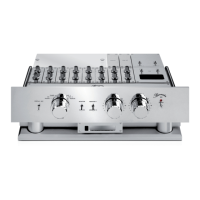The ConCepT
Owner‘s Manual 808 MK5
11
Why a balanced signal path?
In conventional stereo systems the signal flows back and forth through different
(asymmetrical or unbalanced) paths: The negative portion makes its way through the
shielding (mass) of the cable and is, therefore, prone to modulation by transformer
hum, radio interference and other electrical noise. Furthermore, the signals are very
small and are thus easily influenced by paths that vary in material, length or diameter.
By contrast, in a balanced design both signal carrying paths are identical (symmetrical).
The surrounding shielding for grounding the cable is completely separated from the
signal path. Hum and intermodulation are strongly reduced and identical conditions for
both paths ensure that even the smallest signals remain undisturbed. However, in
addition to a more complex internal layout of the components this requires three-
instead of two-pin plugs and terminals as well special cable. We have developed our
interconnects BURMESTER LILA and BURMESTER SILVER for this application. It is
manufactured exclusively for us.
Balanced interconnections have been the rule in music studios for a long time.
However, studio technology only uses balanced transformer stages with amplification
circuits that remain unbalanced. This has distinct disadvantages which we avoid by
carrying the balanced design into the first preamplification stage.
For a better understanding of the functioning and the design of the 808 MK5
explained on the following pages, please also refer to “The System” on page5
and “The Flow Chart” on page8 .

